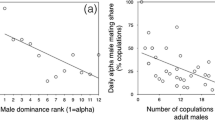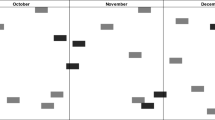Summary
In a group of captive chimpanzees (Pan troglodytes), we studied whether females received more social benefits from males when they were in oestrus than at other times and whether males distributed their beneficial acts especially to females with whom they mated more frequently. When in oestrus, females were groomed more frequently by males than at other times. There was an indication that females were groomed especially by those males with whom they mated more often. From the male point of view, the relationship between active grooming and copulation frequency held only in interactions with oestrous females. No difference was found in the male's tendency to share food with females in oestrous or anoestrous condition. Further, clear disadvantages were associated with being in oestrus: females received support from males less frequently and were more often involved in conflicts with males than in their anoestrous period. Higher ranking males did not mate more often. No relationship was found between the frequency with which a male copulated with a given female and her dominance rank, age or parity, nor did he support her or share food more often with her.
Similar content being viewed by others
References
Adang OMJ, Wensing JAB, Hooff JARAM van (1987) The Arnhem Zoo colony of chimpanzees Pan troglodytes: development and management techniques. Int Zoo Yearb 26:236–248
Altmann J (1974) Observational study of behaviour: sampling methods. Behaviour 49:227–267
Bateman AJ (1948) Intra-sexual selection in Drosophila. Heredity 2:349–368
Boesch C, Boesch H (1989) Hunting behavior of wild chimpanzees in the Tai National Park. Am J Phys Anthropol 78:547–573
Cowlishaw G, Dunbar RIM (1991) Dominance rank and mating success in male primates. Anim Behav 41:1045–1056
Darwin C (1871) The descent of man and selection in relation to sex. Murray, London
Goodall J (1986) The chimpanzees of Gombe: patterns of behavior. Belknapp press of Harvard University Press, Cambridge Massachussets London
Hasegawa T, Hiraiwa-Hasegawa M (1983) Opportunistic and restrictive matings among wild chimpanzees in the Mahale mountains, Tanzania. J Ethol 1:75–85
Hasegawa T, Hiraiwa-Hasegawa M (1990) Sperm competition and mating behavior. In: Nishida T (ed) The chimpanzees of the Mahale mountains. Sexual and life history strategies. University of Tokyo Press, Tokyo, pp 115–132
Hemelrijk CK (1990a) Models of, and tests for, reciprocity, unidirectionality and other social interaction patterns at group level. Anim Behav 39:1013–1029
Hemelrijk CK (1990b) A matrix partial correlation test used in investigations of reciprocity and other social interaction patterns at group level. J Theor Biol 143:405–420
Hemelrijk CK, Ek AE (1991) Reciprocity and interchange of grooming and support in captive chimpanzees. Anim Behav 41:923–935
Hochberg Y (1988) A sharper Bonferroni procedure for multiple tests of significance. Biometrika 75:800–802
Hooff JARAM van (1973) The Arnhem Zoo chimpanzee consortium: an attempt to create an ecologically and socially acceptable habitat. Int Zoo Yearb 13:195–205
Hooff JARAM van (1974) A structural analysis of the social behaviour of a semi-captive group of chimpanzees. In: Cranach M von, Vine I (eds) Social communication and movement. Academic Press, London, pp 75–162
Lawick-Goodall J van (1968) The behaviour of free-living chimpanzees of the Gombe stream area. Anim Behav Monogr 1:161–311
Mantel N (1967) The detection of disease clustering and a generalized regression approach. Cancer Res 27:209–220
Nishida T (1979) The social structure of chimpanzees of the Mahale Mountains. In: Hamburg DA, McGown ER (eds) The great apes. Benjamin/Cummings, California, pp 73–121
Nishida T (1983) Alpha status and agonistic alliance in wild chimpanzees (Pan troglodytes schweinfurthii). Primates 24:318–336
Nishida T, Hiraiwa-Hasegawa M (1987) Chimpanzees and bonobos: cooperative relationships among males. In: Smuts BB, Chewey DL, Seyfarth RM, Wrawgham RW, Strushaker TT Primate societies. The University of Chicago Press, Chicago London, pp 165–177
Noë R, Sluijter AA (1990) Reproductive tactics of male savanna baboons. Behaviour 113:117–170
Noë R, Waal FBM de, Hooff JARAM van (1980) Types of dominance in a chimpanzee colony. Folia Primatol 34:90–110
Seyfarth RM (1978a) Social relationships among adult male and female baboons. I. Behaviour during sexual consortship. Behaviour 64:204–226
Seyfarth RM (1978b) Social relationships among adult male and female baboons. II. Behaviour throughout the female reproductive cycle. Behaviour 64:227–247
Smuts BB (1983a) Dynamics of ‘special’ relationships between adult male and female olive baboons. In: Hinde RA (ed) Primate social relationships An integrated approach. Blackwell, Oxford, pp 112–115
Smuts BB (1983b) Special relationships between adult male and female olive baboons: selective advantages. In: Hinde RA (ed) Primate social relationships An integrated approach. Blackwell, Oxford, pp 262–266
Smuts BB (1985) Sex and friendship in baboons. Aldine, Hawthorne, NY
Smuts BB (1987) Sexual competition and mate choice. In: Smuts BB, Chewey DL, Seyfarth RM, Wrawgham RW, Strushaker TT (eds) Primate societies. University of Chicago Press, Chicago London, pp 385–399
Sokal RR, Rohlf FJ (1981) Biometry. Freeman, San Francisco
Takahata Y (1990) Adult males' social relations with adult females. In: Nishida T (ed) The chimpanzees of the Mahale mountains. Sexual and life history strategies. University of Tokyo Press, Tokyo, pp 133–148
Trivers RL (1972) Parental investment and sexual selection. In: B Campbell (ed) Sexual selection and the descent of man. Aldine, Chicago, pp 1871–1971
Tutin CEG (1979) Mating patterns and reproductive strategies in a community of wild chimpanzees (Pan troglodytes schweinfurthii). Behav Ecol Sociobiol 6:29–38
Waal FBM de (1978) Exploitative and familiarity-dependent support strategies in a colony of semi-free living chimpanzees. Behaviour 66:268–312
Waal FBM de (1982) Chimpanzee politics. Jonathan Cape, London
Waal FBM de (1984) Sex differences in the formation of coalitions among chimpanzees. Ethel Sociobiol 5:239–255
Yerkes RM (1939) Social dominance and sexual status in the chimpanzee. Q Rev Biol 14:115–136
Yerkes RM (1940) Social behavior of chimpanzees: dominance between mates in relation to sexual status. J Comp Psychol 30:147–186
Author information
Authors and Affiliations
Rights and permissions
About this article
Cite this article
Hemelrijk, C.K., van Laere, G.J. & van Hooff, J.A. Sexual exchange relationships in captive chimpanzees?. Behav Ecol Sociobiol 30, 269–275 (1992). https://doi.org/10.1007/BF00166712
Received:
Accepted:
Issue Date:
DOI: https://doi.org/10.1007/BF00166712




